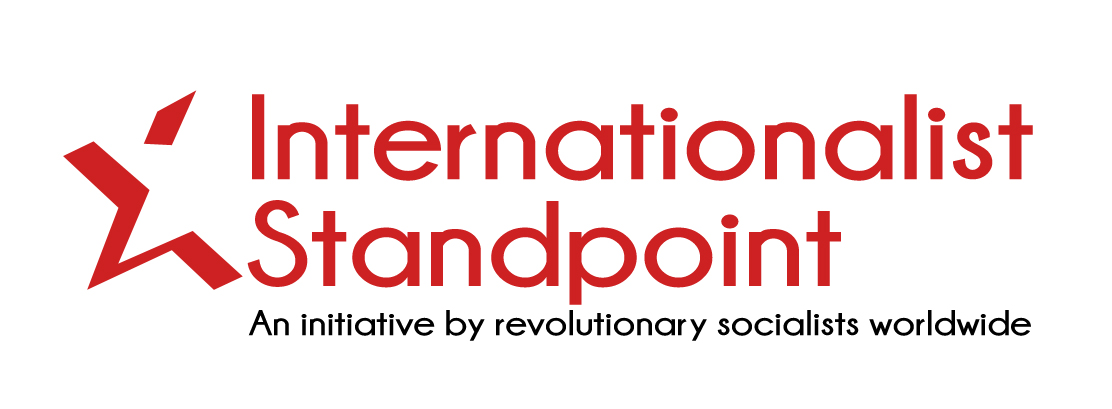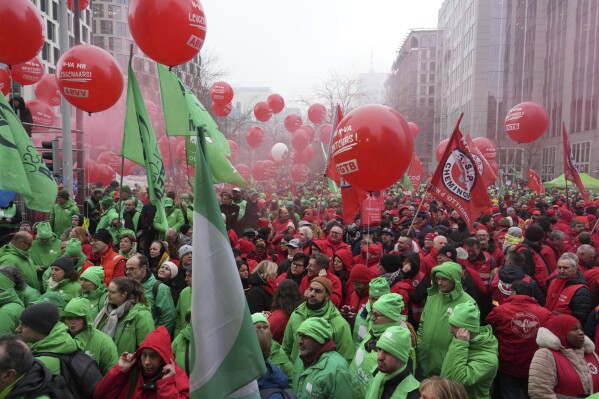On February 13, 100,000 workers demonstrated in Brussels against the plans of the newly formed De Wever-Bouchez government.
The protesters included trade union activists from various sectors and both regions of the country, left-wing organisations as well as civil society groups such as those focused on poverty reduction and refugee aid.
This demonstration sent a strong message to the right-wing government and employers. It was the largest trade union mobilization in decades, reflecting the anxiety, outrage, fear, and anger of many workers in response to the new government’s announced measures.
These measures represent a direct attack on living standards, gains and rights of the working class. They constitute the most severe assault in several decades, comparable to the policies of Margaret Thatcher in the 1980s.
“Two democracies”?
Bart De Wever, who had long argued that confederalism was the only solution to Belgium’s problems and had initially hoped for a deal with the Walloon PS (Socialist Party), saw an opportunity after the June 9, 2024 elections to form an entirely right-wing government.
For years, De Wever had promoted his theory of “two democracies” (right-leaning Flanders and left-leaning Wallonia), advocating for confederalism as the answer—a far-reaching dismantling of the Belgian federal state, which would lead to the division and erosion of the welfare state.
In the June 9 elections, his party, the N-VA (New Flemish Alliance), remained the largest party despite the growth of the far-right Vlaams Belang (VB). This victory gave De Wever the initiative to form a government. Initially, he aimed to create a “two-year emergency economic government” with the PS and work on state reform.
However, the election results shattered the myth of the “two democracies.” In “right-leaning” Flanders, alongside the rise of the VB, the left-wing PTB-PVDA (Workers’ Party of Belgium) and the social-democratic Vooruit (Forward) also made significant gains. In “left-leaning” Wallonia, votes shifted from the PS to the liberal MR (Reformist Movement) and the centrist Les Engagés (The Committed), while the PTB saw a slight stagnation.
Across both regions, the elections highlighted growing polarization within society, reflecting widespread discontent.
Coalition talks
In terms of parliamentary seats, the Right secured a majority both federally and in the Walloon and Flemish regional parliaments. The PS moved into opposition, while Vooruit left the door open for coalition talks.
The backbone of the government was formed by the Walloon liberals (MR) and the Flemish nationalists (N-VA), supplemented by the ex-Christian-democratic centrist parties (CD&V and Les Engagés). However, after the Flemish liberals opted for opposition due to their significant electoral defeat, the coalition no longer had a majority. This led to the inclusion of the Flemish social democrats (Vooruit) in the coalition talks.
The negotiations to form the coalition dragged on for months, but the direction was clear from the outset: to implement as right-wing a policy as possible.
Vooruit attempted to introduce some “left” elements but repeatedly stumbled upon the resistance of the MR. The centrist parties also hesitated, fearing backlash from their supporters. The contradictions in their positions reflected the broader unrest in society. As a result, the hoped-for swift formation of a government did not materialize, and the focus shifted to the approaching municipal elections of October 13.
Coalition talks were paused in August, with all parties concentrating on the new election campaign. Each party feared being punished by voters, even before the government could begin its work.
The results of the municipal elections in October did not produce a significant shift, despite some coalition plans having already been leaked. After the elections, discussions resumed, but by then, trade union protests were gaining momentum. Both Vooruit, which has ties to the socialist trade union ABVV, and the two centrist parties associated with the Christian trade union ACV grew increasingly nervous. They made additional demands, which frustrated the right-wing parties.
Resistance and pressure
In society, a broader awareness of what was coming began to take hold, fueling resistance.
On December 13, a national gathering of a few thousand activists, primarily from the healthcare sector, took place in Brussels. Pressure on the union leadership mounted, and a proposal was made to take action on the 13th of every month. Through information campaigns, discussions, and propaganda, efforts were made to build momentum for the next action on January 13. While the initial goal was to mobilize a few thousand activists, the event grew into a demonstration of 30,000 participants from various sectors, with a strong presence from the education sector. Strikes also took place, including an expansion of action by railway staff.
Thus, the battleground shifted from the political arena to the trade unions—from the ballot box to workplaces and the streets.
Leaked plans about cuts to civil servants’ pensions had sparked widespread concern and anger. Bourgeois circles, followed by mainstream media, attempted to frame the issue as if only teachers were complaining. For days, the narrative focused on civil servants having “gigantic” pensions and shorter working hours, particularly teachers, while workers in more physically demanding jobs would have to work until 67 for less. This marked the beginning of a divide-and-rule strategy.
Attention was diverted from the reality that civil servant pensions are not excessively high, but rather that pensions in other sectors are too low.
The austerity logic was repeated like a mantra: “The money has run out.” Since 1986, successive governments had attempted to dismantle workers’ rights, often paving the way for further attacks. Each time, resistance from trade unions forced bourgeois politicians to hesitate.
Frequently, Walloon-Flemish contradictions were exaggerated to divide and weaken the working class. Migration was also exploited with racist arguments, allowing the far-right Vlaams Belang (VB) to grow steadily. Many workers’ votes were lost to the Far-right.
Direct attacks
On February 6, the coalition government led by Bart De Wever received parliamentary approval. Vooruit attempted to justify the severe cuts by ensuring that “even the strongest shoulders” would contribute, demanding a capital gains tax on investments. However, due to strong opposition from the liberal MR, this measure was watered down to a symbolic gesture. As a result, the tax was approved “in principle,” but its implementation remains subject to further negotiation. Even if applied, it would only raise €500 million by 2029.
Meanwhile, billions are being cut from pensions, unemployment benefits, and refugee support. At the same time, a wage freeze has been introduced, and the wage indexation system—which links wages to inflation—is being questioned. While it has not been abolished outright, it will be “evaluated” later.
On the other hand, funds have been found to increase defense spending. The government aims to cut pensions by limiting those of civil servants and raising the retirement age for everyone. Workers will now need to demonstrate a minimum number of years worked, with unemployment days excluded and sick days more difficult to count.
Unemployment benefits will be limited to two years, down from the previous indefinite period. This rule had been won through struggle to hold employers accountable for not providing sufficient jobs.
Meanwhile, more companies are closing their doors, making it increasingly difficult for dismissed workers—often older ones—to find new employment. The government also plans to negotiate changes to the status of trade unions, aiming to restrict their freedom of action and rights.
Refugees will have to wait longer for financial support—up to five years—and rejected asylum seekers will face faster deportation. Additionally, the government wants to reverse progress in energy supply, moving backward on sustainable solutions.
General strike on March 31
During the initial protests, the Flemish union leadership gave some credit to Vooruit, framing the actions not as opposition to the party but as support for its “left-wing input.” However, this position has been overtaken by events.
The momentum behind the February 13 demonstration, fueled by the announcement of these measures, led to a massive turnout of 100,000 people. This forced the union leadership to call for a 24-hour general strike on March 31.
Meanwhile, teachers in the French-speaking part of the country staged a 48-hour strike against the Walloon government’s decision to abolish permanent appointments. Vooruit claims it has prevented the worst, but in reality, it has fully embraced the logic of austerity.
In a televised debate, a viewer asked a social democratic minister whether it was “socialist” to join such a right-wing demolition government. The minister replied that as a “socialist,” one must think of future generations and ensure there is enough money for pensions. His vision of socialism appears to be about “managing” the existing capitalist system without challenging it—and without touching the profits of capitalists. Not a word was said about the immense profits recently made, on which no taxes have been paid.
The struggle must not be one-off
This government must be fought at the trade union level, with a well worked-out plan of strikes and demonstrations. A single strike will not be enough, as it plans to implement anti-social measures for five years. Unions have the duty to present a plan for escalation, until the government backs down. This plan needs to be thoroughly discussed in every workplace at a rank-and-file level.
At the same time, the battle takes on a political character. The parliamentary majority does not reflect the will of the majority of the population. Politicians have lied to their voters.
That is why we must also work toward building a political alternative. We need a party that truly stands up for the interests of ordinary working people—one that fights to maintain living standards, improve working conditions, preserve social security, and defend the right to strike and other democratic rights. Unfortunately, PTB-PVDA lacks an anti-capitalist programme and also is not willing to democratically organise its internal life.
We need a party capable of uniting all militant workers and presenting a democratically discussed program as an alternative to capitalism. It must strive for the unity of the working class and stand firmly against discrimination, racism, and all forms of nationalism, including Flemish or Walloon.



